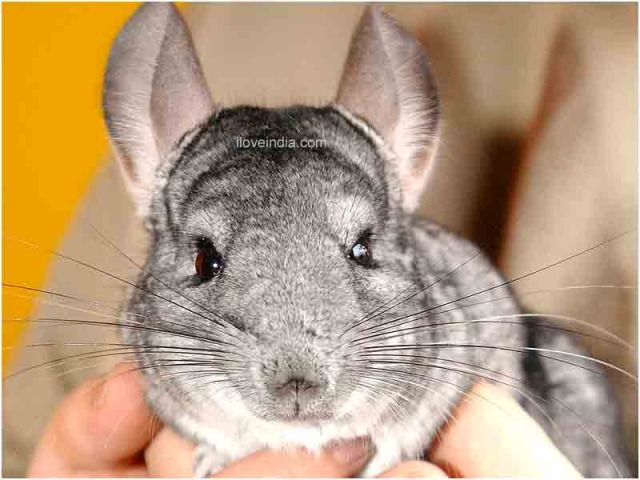Chinchilla, a rodent belonging to the Chinchillidae family, is native to the Andes Mountains in South America. Let's check out some interesting facts and amazing information on chinchillas.
Chinchilla Facts
Chinchillas are named after the Chincha tribe of the Andes, who were known for wearing its fur in the past. Chinchilla is the name of a crepuscular rodent, which is native to the Andes Mountains in South America. A bit larger in size than the ground squirrels, the rodent belongs to family Chinchillidae, along with viscachas. The term 'chinchilla', meaning 'Little Chinta', has been derived from a South American Indian tribe. Of the two species of Chinchilla, Lanigera is the one that is mostly found in the domestic and pelt scenes. Chinchillas can be classified as nocturnal creatures, which love to sleep during the day and are active at night. One of the unique traits of the rodents is that they grow teeth almost continuously, throughout their lifetime. Today, a large number of chinchillas are farm-raised and domesticated in urban areas. If you want to learn some more interesting facts and amazing information on chinchillas, make use of the information provided below.

Fast Facts
Kingdom: Animalia
Phylum: Chordata
Class: Mammalia
Order: Rodentia
Family: Chinchillidae
Genus: Chinchilla
Species: Chinchilla lanigera and Chinchilla brevicaudata
Length: 10-14 inches
Height: 5-6 inches
Weight (Males): 400-500 grams
Weight (Females): 400-600 grams
Age: 10 years (maximum - 20 years)
Status: Rare
Diet: Insectivores and Herbivores
Age of Maturity: 6 -10 months (at times as early as 3 months)
Gestation Period: 111 days
Number of Offspring: 2
Interesting And Amazing Information On Chinchillas
- Chinchilla is believed to have the softest fur in the world, as much as thirty times softer than human hair.
- Chinchillas have a need to take regular baths in dust or volcanic ash, so as to remove the oil and moisture that gets accumulated in their thick fur.
- Amongst all the land animals, chinchillas have been found to have the highest fur density, with more than 20,000 hairs per square cm.
- The red blood cells in a chinchilla carry way more oxygen than the other rodents.
- Did you know that chinchillas prefer to sleep upside down?
- The growth rate of a chinchilla is 2 to 2.5 inches per year.
- The fur density of chinchillas is so high that skin parasites (such as fleas) will die from suffocation, if they live on the former.
- Chinchillas require a compound habitat.
- In a chinchilla, more than fifty hair can grow from a single follicle, surely great in comparison to one hair per follicle, in humans.
- Chinchillas are very vocal rodents. They communicate with grunts, barking sounds, squeals and chirps.
- When you see a chinchilla grooming himself, it means that he is happy or relaxed.
- Chinchillas have been known to be good jumpers, easily jumping up to five feet above their head.
- The body temperature of a chinchilla remains between 96.8°F and 100.4°F, with the heart rate being around 100 beats/minute.
- Chinchillas have a defense mechanism known as the ‘fur slip’. This means, that if they are grabbed by a predator, they have the ability to lose that particular patch of fur, leaving their predator with only a clump of hair.
- The estrous cycle of a chinchilla lasts for 40 days.
- At the time of their birth, chinchilla offspring weigh around 35 grams and have their eyes open.
- Chinchillas are very adaptive when it comes to sleep and can sleep in the tiniest of holes, crevices or spaces.
- Whenever they get frightened, chinchillas release a patch of fur, mainly to escape the grasp of a predator. The hair grows back after sometime.
- Being devoid of dander, one of the leading causes of pet-related allergies, chinchillas are preferred as pets.
- In the wild, chinchillas often live in groups that carry up to 100 members. They are highly social animals and can ‘die’ of boredom.
- The predators of chinchillas, in the wild, include birds of prey, skunks, felines, snakes and canines.
- Chinchillas are prone to dental disease, especially if they do not have a proper diet.
- Chinchillas have a similar hearing range to that of the humans. They can hear the same tones and pitches as us, although their ears are a lot more sensitive.
- Chinchillas have 20 hypsodontic teeth.
See also
More from iloveindia.com
- Home Remedies | Ayurveda | Vastu | Yoga | Feng Shui | Tattoos | Fitness | Garden | Nutrition | Parenting | Bikes | Cars | Baby Care | Indian Weddings | Festivals | Party ideas | Horoscope 2015 | Pets | Finance | Figures of Speech | Hotels in India : Delhi | Hyderabad | Chennai | Mumbai | Kolkata | Bangalore | Ahmedabad | Jaipur
- Contact Us Careers Disclaimer Privacy Policy Advertise With Us Lifestyle Sitemap Copyright iloveindia.com. All Rights Reserved.




